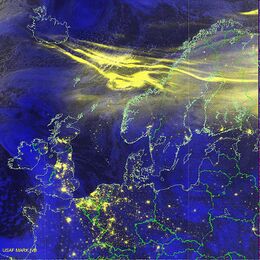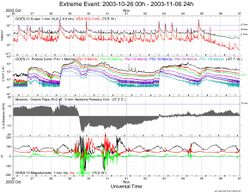Astronomy:2003 Halloween solar storms
 Composite image showing aurorae over northern Europe, taken by DMSP on October 30, 2003 | |
| Type | Geomagnetic storm |
|---|---|
| Formed | October 2003 |
| Dissipated | November 2003 |
| Damage | Electrical faults and wear to various satellites |
| Power outages | Satellite communications blackouts; localized power outage in Sweden |
| Areas affected | Worldwide |
Part of Solar cycle 23 | |
The Halloween solar storms were a series of solar storms involving solar flares and coronal mass ejections that occurred from mid-October to early November 2003, peaking around October 28–29.[1][2][3] This series of storms generated the largest solar flare ever recorded by the GOES system, modeled as strong as X45 (initially estimated at X28 due to saturation of GOES' detectors).[4][5]
Effects
On Earth
Satellite-based systems and communications were affected, aircraft were advised to avoid high altitudes near the polar regions,[6] and a one-hour-long power outage occurred in Sweden as a result of the solar activity.[2] Aurorae were observed at latitudes as far south as Texas [2] and the Mediterranean countries of Europe.[6] Twelve transformers in South Africa were disabled and had to be replaced, despite the country's low geomagnetic latitude.[7]
On satellites and spacecraft
The SOHO satellite failed temporarily and the Advanced Composition Explorer (ACE) was damaged by the solar activity.[2] Numerous other spacecraft were damaged or experienced downtime due to various issues. Some of them were intentionally put into safe mode in order to protect sensitive equipment.[6] Astronauts aboard the International Space Station (ISS) had to stay inside the more shielded parts of the Russian Orbital Segment to protect themselves against the increased radiation levels.[8]
Emissions from the CME were later observed by the Mars Odyssey spacecraft orbiting Mars, Ulysses spacecraft near Jupiter, and the Cassini spacecraft en route to Saturn. In April 2004, Voyager 2 was also able to detect them as they reached the spacecraft.[8]
Analysis
One of the solar storms was compared by some scientists in its intensity to the Carrington Event of 1859.[9]
These events occurred during solar cycle 23, approximately three years after its peak in 2000, which was marked by another occurrence of solar activity known as the Bastille Day event.
See also
References
- ↑ "The Magnetic Storm of Halloween 2003". United States Geological Survey: Science Features. 15 October 2013. http://www.usgs.gov/blogs/features/usgs_top_story/the-magnetic-storm-of-halloween-2003-2/. Retrieved 15 May 2014.
- ↑ Jump up to: 2.0 2.1 2.2 2.3 "NASA - Halloween Storms of 2003 Still the Scariest". NASA/SOHO. 27 October 2008. http://www.nasa.gov/topics/solarsystem/features/halloween_storms.html#.U3TQ_yj9wjI. Retrieved 15 May 2014.
- ↑ Balch, Christopher (2004). Service Assessment: Intense Space Weather Storms October 19 – November 07, 2003. NOAA Technical Memorandum. Silver Spring, MD: Department of Commerce. https://www.weather.gov/media/publications/assessments/SWstorms_assessment.pdf.
- ↑ "2003 Halloween solar storms, sunspot region 2192". SpaceWeatherLive.com. 28 October 2014. https://www.spaceweatherlive.com/en/news/view/46/20141028-2003-halloween-solar-storms-sunspot-region-2192. Retrieved 9 August 2017.
- ↑ "Biggest ever solar flare was even bigger than thought". American Geophysical Union. 15 March 2004. http://www.spaceref.com/news/viewpr.html?pid=13844. Retrieved 9 August 2017.
- ↑ Jump up to: 6.0 6.1 6.2 NOAA Technical Memorandum OAR SEC-88: HALLOWEEN SPACE WEATHER STORMS OF 2003. Boulder, Colorado: NOAA Office of Oceanic and Atmospheric Research. June 2004. http://www.swpc.noaa.gov/Services/HalloweenStorms_assessment.pdf.
- ↑ Solar storm risk to the north American electric grid. input from Homeier, Nicole; Horne, Richard; Maran, Michael; Wade, David. Lloyd's of London. 2013. http://www.lloyds.com/~/media/lloyds/reports/emerging%20risk%20reports/solar%20storm%20risk%20to%20the%20north%20american%20electric%20grid.pdf. Retrieved 2019-07-31.
- ↑ Jump up to: 8.0 8.1 Levin, Eric (2 January 2005). "2003 Halloween Storms Still Rock Solar System". Discover. http://discovermagazine.com/2005/jan/halloween-storms-rock-solar-system. Retrieved 15 May 2014.
- ↑ Cid, Consuelo; E. Saiz; A. Guerrero; J. Palacios; Y. Cerrato (2015). "A Carrington-like Geomagnetic Storm Observed in the 21st Century". J. Space Weather Space Clim. 5 (A16): A16. doi:10.1051/swsc/2015017. Bibcode: 2015JSWSC...5A..16C.
 |


